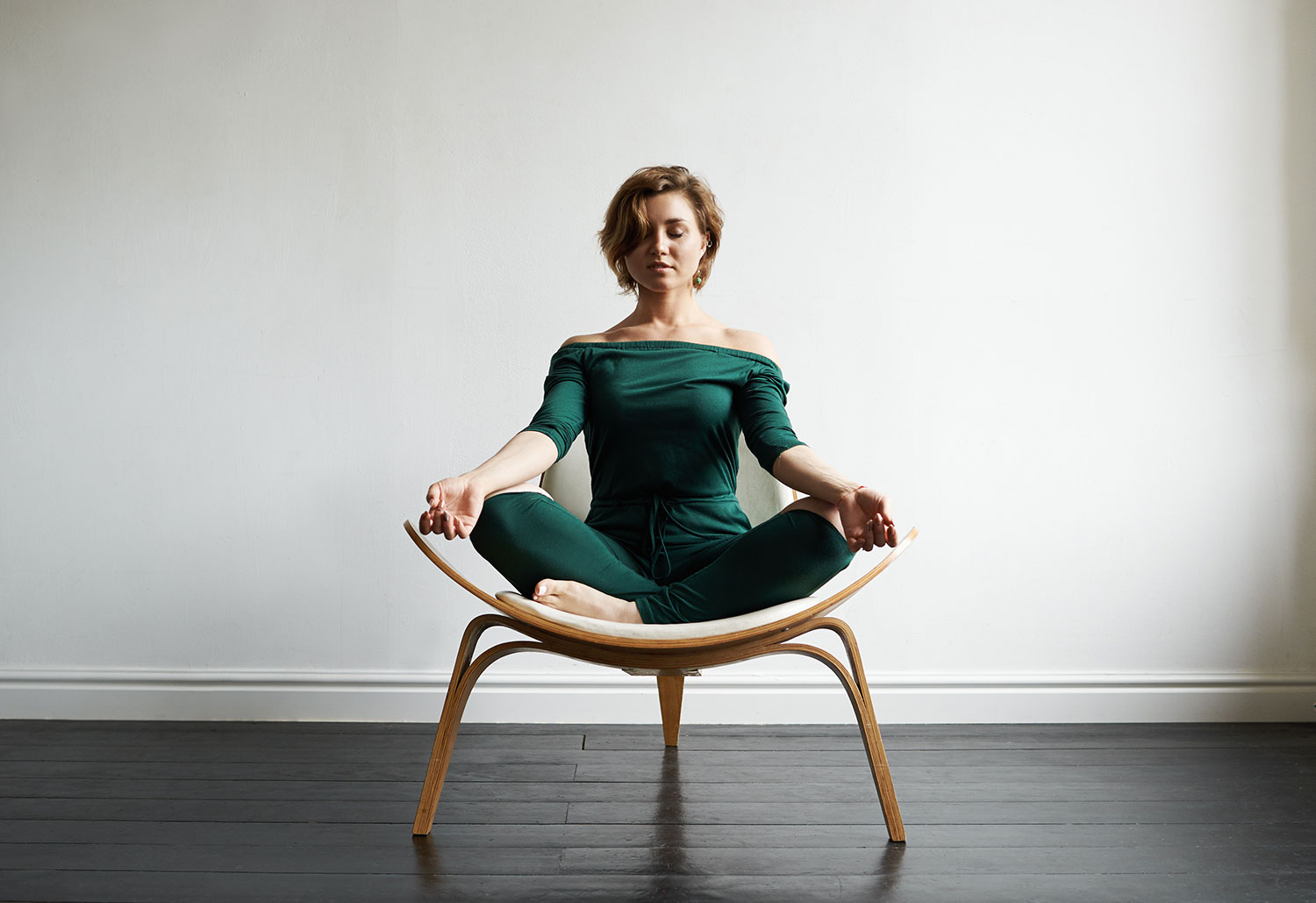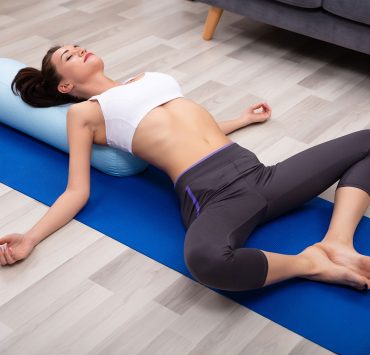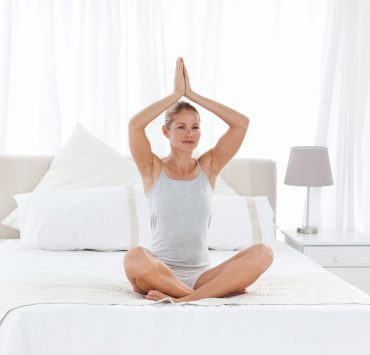
Susan views the world through a lens of spirituality, health,…
Just like its name states, Chair Yoga is yoga done with the assistance of a chair as a yoga prop. Chair yoga may be practiced by anyone regardless of age, body type, or mobility. It helps to work on strength, balance, and coordination in ways that yoga without a chair may not be able to target as quickly.
Who Can Benefit from Chair Yoga

Many people think that chair yoga is only for beginners or those with mobility issues. But chair yoga has benefits even for those who already have a regular asana practice. The chair helps to act as a yoga prop to hold the body in some areas so you can focus on other aspects of poses you are already familiar with.
And for new to yoga students and students with mobility issues due to age, chronic conditions, or injury, chair yoga offers a safe and easy way to practice yoga without worrying about the limitations of the body.
Chair Yoga Practices to Get You Started
If you’d like to explore a whole new world of asana possibilities through chair yoga, try these poses and movements in your practice.
Seated Chair Yoga Asana
To get you started in a chair yoga practice, here are a few yoga asana to explore. These seated poses are accessible to anyone beginning a yoga practice.
Easy Seat

Most people know how to sit in a chair. Easy Seat Pose in a chair encourages you to be mindful of the way you sit, checking that your spine is straight and your weight is distributed evenly on the back of your legs and buttocks that are in contact with the chair. Meditation practices like Transcendental Meditation encourage sitting in a chair with eyes closed this way for 20 minutes twice a day rather than sitting on the floor.
Other Arm Positions

Other arm positions can also be explored while seated and keeping the feet flat on the floor. Garudasana or the arm position of Eagle pose is a great shoulder and back stretch. Gomukhasana, or Cow Face Pose arms are a shoulder and chest opener. Try out other arm positions while remaining seated in your chair. You may discover new aspects of a pose and your body by removing the placement of the legs and feet from the equation.
Leg Raises

Different variations of leg raises will help to work on core and leg muscles and joints even while seated. Start with raising one knee in the direction of your chest, bringing the foot back down to the floor and raising the other knee. Progress towards raising one extended leg off the ground as high as you can and then the other. For even more of a core targeting move, raise both extended legs up off the floor at the same time and hold them up for a few breaths before setting them back down again.
For even more of a challenge, practice various arm positions as you raise your legs either one at a time or at the same time.
Cat-Cow Stretches Poses

Explore spinal movement while synchronizing with your breath. Cat and Cow stretches don’t need to be done on all fours in Tabletop. The same spine, chest, and back stretches can be practiced even in chair yoga. With every inhale, puff your chest forward and heart upwards to the sky, allowing your head to tilt back slightly. With every exhale, pull your heart in towards your spine, shoulders forward, and let your neck relax forward. Hold on to your knees as you breathe into these two poses to maximize the movement with the length of your breath.
Side Stretches

With some front and back flexion in the spine, don’t forget some side stretches too. Raise your arms above your head and either interlace your fingers, hold on to one wrist, or interlace all fingers and release the index fingers into Kali mudra. Inhale, reach up to lengthen the spine, and exhale to lean over to one side, keeping both sit bones in contact with the chair to keep the hips even. After a few breaths focusing on stretching one side, inhale back up to center and exhale, lean in the other direction to stretch the opposite side of the body.
Ardha Uttanasana — Forward Fold Pose

This pose is a gentler way to access to forward bending motion of your hip flexors, without worrying too much about the tightness of your hamstrings preventing you from going deeper into the pose. It’s also a perfect opportunity to practice the brace position for emergency landings or encountering turbulence when in an airplane!
Keep the feet flat on the floor, sit bones and back of the thighs in contact with the chair, and hips evenly facing forward as you hinge into a chair yoga forward fold. If you’re able to touch your chest to your legs, relax the neck and hold on to opposite elbows with your hands underneath your legs.
Twists Poses

Twists feel great while doing chair yoga to decompress the spine and energize the digestive system and internal organs. If your chair has arm rests, gently twist to one side and use the arm rests as support to hold the twist. If your chair does not have arm rests and you have room on either side of you, change the orientation of how you sit so that your legs are facing the side and your side body is on the back rest. Twist to face the back of the chair and hold the back rest for support.
Seated Pigeons

The chair is a great yoga prop to work on opening your hips into pigeon pose. While seated, cross one ankle over the thigh of the other leg to form a seated figure four shape with your legs. Keep your ankle flexed to protect your knee, especially if your hip flexors are still tight. Depending on the openness of your hips, you may be able to forward fold with your legs still in pigeon to gently deepen the pose.
Standing Chair Yoga
You are not limited to seated asana when practicing chair yoga. Many standing poses may be assisted or supported with a sturdy chair to either go deeper into a standing pose, or to be mindful of your body and using the chair to help you into certain asana shapes.
Adho Mukha Svanasana — Downward Facing Dog

Try these two variations of Downward Facing Dog with a chair to target different areas of your practice.
The first variation requires that your chair is stable and will not slide out from under you. Best to position your chair by a wall so that it can lean and stay put. Get into Adho Mukha Svanasana by placing your hands on the floor at the base of the chair and your feet on the edge of the chair. Walk your hands forward so your legs can extend fully and your feet remain on the chair lifted from the balls of your feet. This will physically work your balance, core, arms, and legs. On a mental and emotional level it will challenge your perspective and even fears and blockages.
The second variation is not as intense and focuses more on stretching the hamstrings and opening the heart space.
Stand behind the chair with both hands on the back rest. Walk back far enough so you can extend your hands forward as you hinge from the hips and fold. This chair yoga version of Downward Facing Dog looks like and targets most of the same areas as Uttanasana, or Forward Fold. The difference is keeping an inward rotation of the upper arms as you hold on to the chair to keep the same arm muscles engaged as if you were doing it on the floor.
Trikonasana — Triangle

Trikonasana, or Triangle Pose with a chair may be practiced using the chair as a support, especially if an injury or other mobility issues prevent you from going deep enough in the pose to reach the floor or even a block on the ground to lean on. Use the chair almost like an oversized block as you practice Triangle pose, placing your bottom hand either on the seat portion or on the backrest of the chair to help hold yourself up in Trikonasana.
Conclusion
Chair yoga can open up your practice to a new range of possibilities to go deeper into different asana. It’s also a great entry point for those who have always wanted to try yoga but have been afraid that limited mobility might be an issue ay a regular group yoga class.These poses not only reap the same benefits as their original, traditional counterparts, they are also accessible and simple even in a yoga class for beginners.
What's Your Reaction?
Susan views the world through a lens of spirituality, health, and compassion. Her positive outlook on life shines through her writing, which is heavily focused on yogic living, meditation, and conscious eating.














